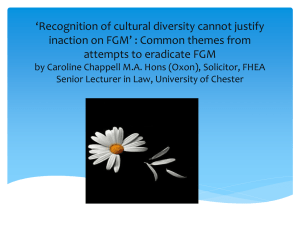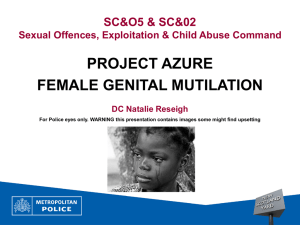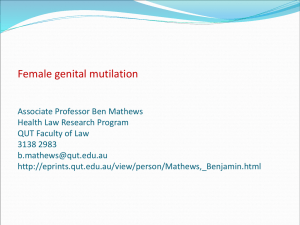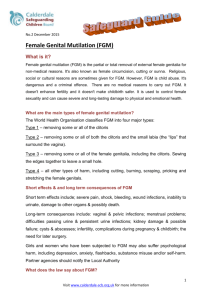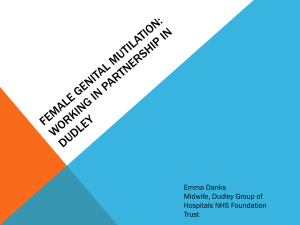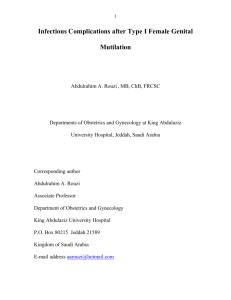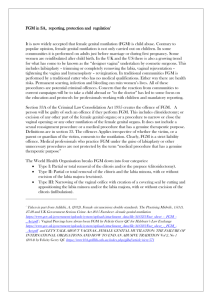Here - Psychology
advertisement
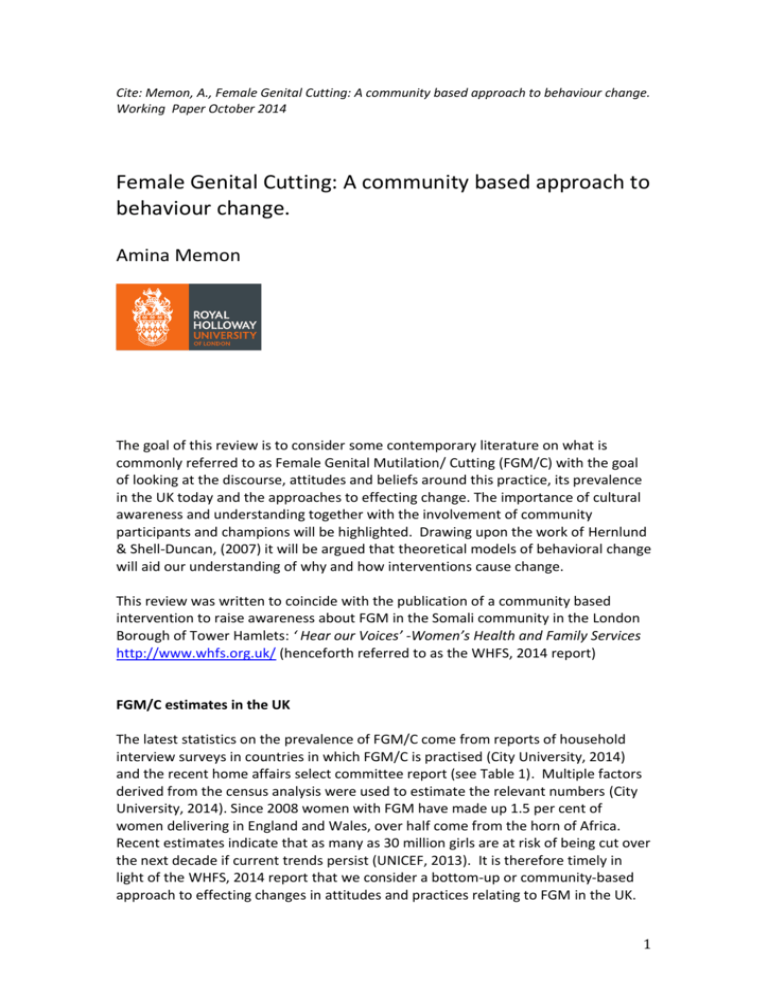
Cite: Memon, A., Female Genital Cutting: A community based approach to behaviour change. Working Paper October 2014 Female Genital Cutting: A community based approach to behaviour change. Amina Memon The goal of this review is to consider some contemporary literature on what is commonly referred to as Female Genital Mutilation/ Cutting (FGM/C) with the goal of looking at the discourse, attitudes and beliefs around this practice, its prevalence in the UK today and the approaches to effecting change. The importance of cultural awareness and understanding together with the involvement of community participants and champions will be highlighted. Drawing upon the work of Hernlund & Shell-Duncan, (2007) it will be argued that theoretical models of behavioral change will aid our understanding of why and how interventions cause change. This review was written to coincide with the publication of a community based intervention to raise awareness about FGM in the Somali community in the London Borough of Tower Hamlets: ‘ Hear our Voices’ -Women’s Health and Family Services http://www.whfs.org.uk/ (henceforth referred to as the WHFS, 2014 report) FGM/C estimates in the UK The latest statistics on the prevalence of FGM/C come from reports of household interview surveys in countries in which FGM/C is practised (City University, 2014) and the recent home affairs select committee report (see Table 1). Multiple factors derived from the census analysis were used to estimate the relevant numbers (City University, 2014). Since 2008 women with FGM have made up 1.5 per cent of women delivering in England and Wales, over half come from the horn of Africa. Recent estimates indicate that as many as 30 million girls are at risk of being cut over the next decade if current trends persist (UNICEF, 2013). It is therefore timely in light of the WHFS, 2014 report that we consider a bottom-up or community-based approach to effecting changes in attitudes and practices relating to FGM in the UK. 1 Table 1: FGM estimates It is estimated that 125 million women and girls worldwide have undergone FGM. It is estimated that 3 million girls are subjected to FGM every year It is estimated that 170,000 women and girls are living with FGM in the UK It is estimated that 65,000 girls aged 13 and under are at risk of FGM in the UK Over 200 FGM-related cases investigated by the police nationally in the last five years It has taken 29 years since the criminalisation of FGM for the first prosecutions to be brought Source: Home Affairs Select Committee Report 2014-15 Terminology and the media There has been much debate internationally about terminology in discussing this subject. Female circumcision, the term common in the 1970s, was replaced by the phrase female genital mutilation as a more accurate reflection of the severity of the practice and as a means of ‘condemnatory advocacy’ (Denison, 2014). However during the 1980s and 1990s a body of literature emerged that viewed the term FGM as problematic in a number of ways: to describe someone as ‘mutilated’ is degrading and prejudices debates about women’s autonomy (see also the WHFS, 2014 report). Gunning (1992) notes the arrogant perceptions which typify western criticisms of other cultural practices- “creating polarization between us women who make choices and are part of the modern world and them victims of an oppressive culture”. Moreover, Jones (2000) talks about an ancient cultural right that blights the lives of many women. This negative framing may prohibit rather than encourage women to come forward as supported by the WHFS (2014) report. Thus women may find the term ‘mutilation’ offensive particularly when used by the media and by healthcare staff. Popular media explanations of genital cutting are often simplistic, and give a single underlying explanation, despite the literature documenting wide variations in practice (Gruenbaum 2005). The assumption is that culture and cultural values are homogeneous and unchanging. They also ignore the values of the different groups (males, females, younger, older, community leaders, and ordinary people). Moreover, campaigns to eradicate FGM have ignored diversity and treated it as a single procedure, usually more extreme infibulation - “ a lumping together of diverse forms of practice into genital mutilation” (Walley, 1997). Moreover, the term ‘mutilation’ may alienate members of practising communities and may account for why women who seek reversal operations may not end up attending their appointments to have this procedure undertaken (see WHFS 2014 report). In recognition of these arguments, some commentators adopted what they saw as the more neutral language of female genital surgeries or cutting. Accordingly, this article uses the term female genital mutilation/cutting or FGM/C throughout. (See World Health Organization 2008: 3 and Annex 1 for further discussion.) 2 Why is FGM/C practiced? Drawing upon recent literature reviews and peer reviewed publications on FGM/C (Berg & Dension, 2013; Brady & Files, 2007; Gele et al. 2013; Imoh, 2013; Reig Alcaraz et al. 2014; Vloeberghs et al. 2012) I have listed below the disparate and prevailing beliefs that may account for why FGM/C continues to be practised, as well as reasons why individuals and communities may support the discontinuation of FGM/C. Factors favoring the continuation of FGM/C Social pressure (see social norms approach) Preservation of women’s virginity Aesthetics Male preference and increased sexual pleasure for men To preserve a women’s dignity and honour and avoid shame on entire family Pre-requisite for marriage Cultural conformity: Tradition and Religion (although it is not dictated by any religion) Hygiene and assumed health benefits Lack of knowledge about the practice of health care professionals Discrimination, marginalisation, lack of trust Poor communication Lack of respect for women’s privacy Language difficulties Factors favoring the discontinuation of FGM/C Knowledge of the dangers Media publicity Discussions with family members, community, friends, religious institutions Health concerns and consequences: problems during pregnancy and childbirth Negative personal experience including loss of sexual pleasure Impact on mental health The husband is against it Law of the country of residence* *Where FGM/C is punishable by law, new attitudes towards the eradication of FGM/C are adopted in the women’s place of residence. Dustin (2004) argues that in the UK efforts to reduce FGM/C have focused on punitive legislation without sufficiently empowering women in the communities concerned to engage in debate to change attitudes and create alternative ways of affirming their cultural identity. World Health Organization (WHO) classification of female genital mutilation: 3 The WHO defines FGM/C types as I: partial excision; II: total excision; III: infibulation; IV: pricking, piercing, cauterisation; scraping or cutting the vagina and the introduction of corrosives or herbs1. Somalia has the highest global prevalence of FGM/C and the majority of girls in Somali community are subjected to the most severe form, i.e. infibulations (Gele, Bo & Sundby, 2013). It is this group that are most likely to be traumatised as will be detailed later in this review (Vloeberghs et al. 2012). About 98% of Somali women aged between 15 to 49 have experienced FGM/C according to the UNICEF database which draws on nationally representative surveys and was last updated in July 2014. The traditional practice2 Traditional practitioners without surgical training perform FGM/C with razors, glass, or knives in unsterile conditions. No anaesthetic is used, and relatives hold the girl down. Twigs or rock salt are inserted afterwards to maintain a small opening for urine and menses. The area may be covered with soil or bark before the girl is sewn with thorns or gut, and has her legs bound for three weeks (Momoh 2005). As the environment is unsterile, there is a high risk of tetanus and sepsis. The girl may suffer urinary retention or a haematoma. Other complications include haemorrhage, severe pain, local/systemic infection, shock, and death (Shell-Duncan and Hernlund 2001). The actual number of girls dying from FGM/C is unknown, as many deaths go unreported but anecdotal evidence suggests that over 10% die at the time of the procedure, with the bodies often being disposed of in neighbouring villages until they are taken by animals (Wilson 2008). Longer-term, the stitched area may be so scarred that there is insufficient opening for menses, causing abdominal swelling. The impact of FGM/C on mental health It is beyond the scope of this literature review to discuss the wide ranging and long lasting effects of FGM/C on health and well-being. I have therefore narrowed down this review to considering just one body of evidence that points to the adverse effects on women’s mental health. This review is necessarily selective but illustrates that consequences go beyond the physical and social. The literature on the effects of FGM/C on mental health is sparse but indicates that any of the FGM/C procedures can increase health problems such as anxiety, depression and phobia (see for example, Elnashar & Abdelhady’s (2007) study of newly married women in Egypt). Here I give an example of a recent study that illustrates the importance of involving community members in data gathering and documents the impact of FGM/C on mental well-being. 1 Note all these forms of FGM/C are for non-medical reasons. 2 The practice may differ slightly in different countries. 4 Vloeberghs et al (2012) examined the psychosexual consequences of FGM in the Netherlands. They adopted a mixed methods approach of questionnaires and indepth interviews of 66 women who had migrated from Somalia, Sudan, Eritrea, Ethiopia and Sierra Leone. One sixth suffered from PTSD and a third had symptoms related to depression and anxiety. The Vloeberghs et al (2012) study is based on a culturally-validated structured questionnaire, and in-depth interviews with circumcised migrant women from different countries. To gain women’s trust, members of the community were actively involved in the process of data collection and in the interpretation and analysis of data. Representatives of communities were consulted on the preferred terminology, phrasing of questions and acceptability of research methodology. The interviewers met to see how questions should be formulated, how answers should be noted and how special situations were dealt with (such as refusal to answer/did not understand). The authors analysed the data using grounded theory and triangulation to understand the mental, social and relational consequences of FGM/C in a migration context (see Hammersly and Atkinson, 1983). All respondents were asked about the type of FGM/C they had experienced, at what age it was performed, and how they see it now they are living in the Netherlands. There were some interesting results by the type of procedure the women had undergone. Women who were infibulated and who clearly remembered the event, and women who had education concerning the circumcision, reported more PostTraumatic Stress Disorder (PTSD) symptoms as well as more anxiety and depression. Women who were older at the time and with whom circumcision was discussed also reported more PTSD symptoms. The interesting finding here is that both the severity of the procedure and age at which it occurred appears to be related to the effects of mental health. Nevertheless all the women reported some adverse effects of stress such as recurrent bad memories and nightmares at all times (see Utz-Billing & Kentenich, 2008 for a similar finding). One counter-intuitive finding from the Vloeberghs et al (2012) study is that supportseeking was associated with more mental health complaints. So those who sought support experienced more anxiety and depression than those who did not seek it. Obviously the relationship is complex here, because it may simply mean those who were suffering from more anxiety and depression were more likely and willing to seek help. A number of respondents indicated that they had not received support from people important to them (partners, mothers in law) and a number said they felt lonely and a spectacle when they sought the help of service providers in the Netherlands. The authors developed a taxonomy based on how women are adapting with different rates of success. They classified women into three types based on their questionnaire measures: The Adapted: These women were overcoming FGM/C but continue to be troubled by problems of a physical/sexual nature although they can overcome them. They talk about what bothers them and some are in contact with family but can make 5 decisions independently. For Muslim women, the opinion of the umma or the community is important and comfort can be found in prayer and religion. The Disempowered: These women feel angry and defeated. They bear their grief and do not see any way out - they do not talk about what was done to them, they feel ashamed, alone and disempowered. They avoid sexual contact and are emotionally inhibited. They have a poor relationship with their husbands and feel they would not approach a service provider for help on their own accord. The Traumatised have been infibulated and suffered a lot of pain and sadness. They are divorced/and or in a bad relationship with their husband, they have recurrent memories, sleep problems, chronic stress, they feel misunderstood by their immediate environment and health providers. The women may isolate themselves and experience a high incidence of anxiety/depression. This study is important not only in showing the mental health consequences of FGM /C but in illustrating how important it is not to stereotype or place women in a single category. Instead, we need to look at circumcised women as individuals who may have differing emotional and social needs, and tailor support structures and interventions accordingly. A community focused approach While FGM/C appears to be a violent practice, it is not motivated by violence. Seen from the eyes of the community, it is a rite of passage and of great importance in defining the roles and boundaries of womanhood (Gruenbaum 2001). Evidence from 300 in-depth interviews, 28 focused group discussions and survey data from 1220 women from Senegal and Gambia suggests that FGM/C is indirectly related to marriage via preserving virginity (Shell-Duncan et al. 2011). The authors argue that being circumcised serves as a signal to other circumcised women that a girl has been trained to accept the authority of her circumcised elders and is worthy of inclusion in their social network. In an earlier study, Hernlund and Shell-Duncan (2007) studied Senegalese communities near the northern Gambian border using a mixed method approach including in-depth interviews and focus-group discussions. The researchers were men and women from Gambian families that practiced FGM/C and these field workers immersed themselves in the study communities, carried out participant observation, and wrote field journals and community descriptions. They found that it is the proximate persons or people that are close to individuals (family members, friends and other trusted sources) who shape opinions and intentions around the practice of FGM/C. Shell-Duncan et al (2011) maintain that interventions aimed at eliminating FGM/C should target inter-generational social networks and include both men and women in their discussions. This offers direct support for the conclusions from community-based studies such as that recently completed by WHFS (2014). The important point is that change must be coordinated among interconnected members of social networks and this favours an approach that draws upon cultural values in the community and works with members of that community to understand 6 the barriers to behaviour change. In order to better understand how this could work, we need to have a look at the importance of developing cultural awareness and how this fits with social psychological models that can be used in developing interventions. FGM/C is a belief set in which its value as a cultural tradition takes precedence over any health concerns. As indicated earlier there are social mechanisms in place to encourage it (meeting of family approval, increased marriage prospects). Therefore a good place to start is to with the cultural values. To quote Gruenbaum (2005), “Cultural values can be anchors that reinforce tradition but they can also be the source of ideas for rethinking and challenging cultural practices.” According to Braddy & Files (2007), to foster a more trusting relationship with patients, health care providers must have an accurate understanding of the cultural background surrounding the practice as well as a working knowledge of the different types of practices. Models of Behaviour Change and Interventions to address FGM/C Theoretical models of behavioral change are needed to understand why and how interventions cause change (Askew, 2005; Gele et al., 2013). While awareness of FGM is growing, the issue of behavior change remains poorly understood (Hernlund & Shell-Duncan, 2007). “The decision about whether, when or how to perform FGM/C results in a constant process of negotiation about how to position oneself in the light of shifting social relationships, contexts and experiences.” (Hernlund & Shell-Duncan, 2007). So what are the most important models of behaviour change? Shell-Duncan et al (2011) discuss two approaches: rational choice and the social convention or social norms based approach. A rational choice approach weighs up the costs and benefits of behavioural options for independent actions - for example, community-based health education programmes focused on the delivery of information on the health risks associated with FGM/C. These programmes may raise awareness of FGM but they do not motivate large-scale abandonment of FGC (Shell-Duncan et al 2011). One of the limitations of the rational choice approach is the assumed link between intentions and behaviour. For example, someone may say they intend to have a reversal appointment but then they don’t turn up for their appointment. Thus intentions do not necessarily translate to a change in behaviour especially if there is a lack of trust and understanding. According to social convention theory, the actions of individuals are interdependent in a competitive marriage market and where there is inequality in social and economic resources (Mackie, 1996)3. This model would predict that community3 There are similarities between the practice of FGM/C and that of foot binding in ancient China. Despite the fact that the practice of foot binding lasted for more than 1,000 years, it abruptly ended in a single generation due to the pivotal innovation of pledging (Mackie, 1996 ). This was when a number of families agreed and pledged to 7 based programmes that seek to co-ordinate change within the community, such as that recently initiated by WHFS (2014), are likely to be successful. Applying a social convention model to the practice of FGM/C, it is apparent that it improved the chances of marriage into higher social strata and it became exaggerated and diffused through lower stratas of society as parents attempted to get the best marriage prospects for their daughters. Hence FGM got ‘locked in place’ as a self-enforcing convention (Mackie, 1996). What is now needed is a convention shift or co-ordinated change whereby a critical mass abandon the practice and allow their children to marry women who have not been cut (Shell-Duncan et al 2011). The Tostan model4, which favours the community-centered approach in which community voice and diaglogue is key in anti-FGM decision making (see http://www.tostan.org/female-genital-cutting accessed 18-08-14), provides support for social convention theory. Public declarations supported by the majority of people in a community fit with the social norms literature since they signal the change of a norm among a critical mass, and not just individual attitudes (Mackie and Le Jeune, 2009). This also fits with the modified stages of change theory (see below), according to which people abandon the practice when they find a motivation to do so and have the ability to act upon their decision, i.e. when their social context supports, promotes or at least accepts abandonment. It is interesting to look at this approach in some detail to better understand both the theoretical underpinnings and impact. The stages of change theory (Prosachka and DiClemente, 1983) was originally formulated to assess the behaviour of individuals as opposed to the behaviour of entire communities such as the practice of FGM/C. For this reason, Shell-Duncan modified the ‘stages of change’ theory to help fit it to the practice of FGM/C, in which the decision regarding the abandonment of the practice is not in the hands of any one individual, but rather with a group of decision makers. According to the modified stages of change theory, people abandon the practice when they obtain a motivation to end the practice and have the ability to act upon their decision, i.e. when the interconnected communities agree to stop FGM/C because of a realisation of its harmful effect. In some situations, people may abandon the practice even if they personally want it to continue, e.g. when other decision makers or social pressure force them to stop the practice. One example is when members of Community Management Committee (CMC)5members speak with friends and family and then travel to other communities to raise awareness about what they have not bind their daughters’ feet and also that their sons would only agree to marry women with unbound feet (Goldstein, 2014). 4 Begun in 1991, Tostan, which literally means “break- through” Community Management Committees (CMCs) are made up of 17 democratically elected members and at least nine of the 17 members must be women. Participation in the CMC helps women improve their confidence, leadership, and social standing by assuming prominent roles in their community. The CMCs take forward the community’s vision for sustainable development and as community-based organisations, work with partners and others to meet community needs. 5 8 learned. Hence people who received training in one village took it upon themselves to discuss abandoning FGM with people from other villages (Chege et al. 2001). Tostan is now active in six West African countries (http://www.tostan.org/tostanmodel, accessed 6 June 2014). And so far, over 7,000 communities from Djibouti, Guinea, Guinea-Bissau, Mali, Mauritania, Senegal, Somalia, and The Gambia have declared their intention to abandon FGM. Interviews with people in programmes reached by Tostan – either directly or indirectly through word-of-mouth contact between villages – indicate that public declarations are often effective because people feel bound to honour them (Diop and Askew, 2009). It is well established through previous research conducted with the Somali community in the USA that mobilisation of community social networks and trustbuilding through participation can inform the development of interventional programs to address FGM/C (Johnson, Ali and Shipp, 2011). Moreover, in order to foster a trusting relationship, those providing information need to have an accurate understanding of the cultural background surrounding the practice as well as a working knowledge of different practices (Braddy & Files, 2007). Sensitivity about culture and values and a non-judgemental approach are also critical and hence the importance of identifying community champions to challenge the cultural and language barriers and build trusting relationships. Once again, the research supports the practice of working with communities as they will be the advocates of change. A social norms perspective According to the Home Affairs Select Committee (2014-15) report : “ FGM is a deeply embedded social norm within practising communities - an improved understanding of social norms and communities is needed to break it down.” In 2005, a UNICEF report called Changing a Harmful Social Convention: Female genital mutilation/cutting drew upon social psychological theory to explain the persistence of FGM/C. According to the social norms perspective, people’s behaviour and intention to change their behaviour are governed by the beliefs and practices of significant others (members of their community, for example). Thus beliefs or knowledge about various aspects of the practice – for example, that it causes harm, which is a correct belief or that it is mandated by religion, which is an incorrect belief (Gage and Van Rosen, 2006; Upvall et al. 2009), can influence behaviour. The recent WHFS (2014) report shows how beliefs relating to the role of religion in the practice of FGM/C can be changed. This gets at the heart of what a community-focused approach can achieve, both in terms of understanding the processes governing behaviour change and in motivating changes in practice. Thus a norm may be enforced through community pressures, and collective enforcement may be linked with honour and avoidance of shame. There may be social mechanisms in place both to encourage it (for example, meeting the family’s approval, increasing marriage prospects). The social norms perspective can enrich the understanding of FGM by offering an additional lens for analysing the mechanisms that regulate the practice. The social norm approach is also a central feature of an innovative programme developed by UNICEF with the European Union (2008-2012). The goal was to assess the extent to which, and under what 9 circumstances the UNICEF programme has accelerated the abandonment of FGM/C over the last 5 years. The programme, which is currently under way in 15 African countries, is expected to embark on a second phase from 2014-2017. The preliminary data suggests the social norm perspective has been useful as reported in the preliminary report Joint Evaluation of the UNFPA-UNICEF Joint Programme on Female Genital Mutilation/Cutting: Accelerating Change (2012-2013). So far the programme has resulted in an increase in public commitment from community leaders toward FGM/C abandonment and a change in the public discourse surrounding FGM/C. However, changes at the regional level continue to be slow. Moreover, there is only limited data currently on the specific factors that influence whether and how specific combinations of strategies facilitate changes in behaviour. A systematic comparison of different strategies as well as their cost-effectiveness has yet to be undertaken (UNICEF, 2012). Conclusion FGM/C is deeply rooted in the cultural traditions of its countries of origin (Reig Alcaraz et al. 2014). Shell-Duncan & Hernlund argue that we must be wary of the Trivialisation of culture, whereby the social significance and historical context of a practice is ignored in favour of labeling it as mindless and barbaric, as this can be highly offensive to the very people we are trying to communicate with (Toubia, 1985). . According to social convention theory the actions of individuals are interdependent and this fits with the finding that it is the proximate persons or people that our close to individuals (family members, friends and other trusted sources) who shape opinions and intentions around the practice of FGM/C. Imoh (2012) makes the important point that cultural values are not static and we need to engage local communities in an ongoing dialogue about their own local practices. Furthermore, Imoh argues that this environment of dialogue and self-scrutiny and reflection by local communities presents an opportunity for policy makers and practitioners to develop partnerships with local communities in which the priorities and needs of all stakeholders are seriously considered, rather than imposing behaviour change. The work of Women’s Health & Family Services in Tower Hamlets http://www.whfs.org.uk/ provides us with a fine example of this. Interventions designed to change behaviour without documenting how they work are not evidence-based. WHO (1999) note that one of the most neglected areas is that of applied or operational research on how to design interventions that would convince both individuals and communities to stop the practice. In order to bring about changes in practice with respect to FGM/C, three clear conclusions emerge from this literature review. Hence we need to be careful in our use of terminology and portrayal in the media and health campaigns of FGM/C, so as not to deter women coming forward to seek help. To quote Gruenbaum, 2005, p.8: “Change strategies should be based not on the assumption that traditional beliefs are irrational and just need a good dose of public health education, but should reflect an accurate assessment of the different meanings and motivations” 10 As alluded to throughout this review, interventions need to be based on a sound understanding of the cultural values and social conventions that may dictate the responses of individuals and an entire community. The empirical evidence suggests a community-focused approach that draws upon theory-based models of change is likely to be most successful. “There is a need for ongoing community-based prevention work, including: creating safe spaces for women to talk about FGM, using culturally affirmative approaches, and developing the confidence of community-based champions to counter the concept of FGM/C as essentially linked to cultural identity.” The quote comes from the FGM/C initiative (2013) funded by the Esmee Fairbairn Foundation and ROSA (the UK fund for women and girls). The approach taken was based on Participatory Ethnographic Evaluation Research (PEER), in which PEER researchers were women who had had some contact with the project (for instance, who had attended a workshop), who interviewed ‘friends’ who were known and trusted to them, in order to elicit detailed narratives on FGM/C in the UK. Similarly the WHFS report (2014) also funded by ROSA supports the use of community champions to effect changes in erroneous beliefs that raise awareness among the gatekeepers in the community (be they grandparents, husbands, Imams). References Askew, I. (2005). Methodological issues in measuring the impact of interventions against female genital cutting. Culture, Health & Sexuality, September-October 2005, 7(5), 463-477. Berg, R. & Denison, E. (2013). A Tradition in Transition: Factors Perpetuating and Hindering the Continuance of Female Genital Mutilation/Cutting (FGM/C) Summarized in a Systematic Review. Health Care for Women International, 34:10, 837-85 Brady, C. M., & Files, J. A. (2007). Female genital mutilation: cultural awareness and clinical considerations. J Midwifery Womens Health. 2007 52(2), 158-63. Chege, J., Aksew, I. & Liku, J. (2001) ‘An Assessment of the Alternative Rites Approach for Encouraging Abandonment of Female Genital Mutilation in Kenya’. Washington D.C.: Frontiers in Reproductive Health. Diop, N.J. & Askew, I. (2009). ‘The Effectiveness of a Community-Based Education Program on Abandoning Female Genital Mutilation/Cutting in Senegal’. Studies in Family Planning 40(4): 307-318 Elnashar, A. & Abdelhady., R. (2007). The impact of female genital mutilation on the health of newly married women, International Journal of Gynecology and Obstetrics 97, 238–244. 11 Gage, A.J. & Van Rossem, R. (2006). Attitudes toward the discontinuation of female genital cutting among men and women in Guinea. International Journal of Gynaecology and Obstetrics, 92 (1), 92–96. Gele, A., Bø, B.P. & Sundby, J. (2013). Attitudes toward Female Circumcision among Men and Women in Two Districts in Somalia: Is It Time to Rethink Our Eradication Strategy in Somalia? Obstetrics and Gynecology International Volume 2013, 1-12 Goldstein, R.A. (2014). Female Genital Cutting: Nursing Implications, Journal of Transcultural Nursing 25(1) 95–101 Gruenbaum , E. (2005). Socio-Cultural Dynamics of Female Genital Cutting: Research Findings, Gaps, and Directions Culture, Health & Sexuality, 7, Themed Symposium: Female Genital Cutting (Sep. - Oct., 2005), pp. 429-441 Gunning, I. R. (1992). ‘Arrogant Perception, World Travelling and Multicultural Feminism: The Case of Female Genital Surgeries’, Columbia Human Rights Law Review 23(2): 189–248. House of Commons. Home Affairs Select Committee Report (2014). Female genital mutilation: the case for a national action plan. Second Report of Session 2014-15. London: The Stationery Office Limited Imoh, T-D (2013). Rites vs rights: Female genital cutting at the crossroads of local values and global norms International Social Work 2013 56, 37-50. Jones, J. (2000) ‘Concern Mounts over Female Genital Mutilation’, British Medical Journal 321 (29 July): 262. Johnson C.E, Ali , S.A & Shipp M. P. (2011). Building community-based participatory research partnerships with a Somali refugee community. American Journal of Preventative Medicine, 37, 230-6. Macfarlane, A. & Dorkenoo, E. (2014). Female Genital Mutilation in England and Wales: Updated statistical estimates of the numbers of affected women living in England and Wales and girls at risk Interim report on provisional estimates. City University & Equality Now. ISBN 978-1-900804-92-9. Mackie, G. (1996). Ending footbinding and infibulation: a convention account. American Sociological Review, 61, 999-1017. Mackie, G., & LeJeune, J. (2009). Social dynamics of abandonment of harmful practices: A new look at the theory. Special Series on Social Norms and Harmful Practices: Innocenti Working Paper No. 2009-06. Florence: UNICED Innocenti Research Centre. Momoh, C. (2005). Female Genital Mutilation Radcliffe Medical Press (01235528820) ISBN- 1-85775-693-2 12 Prochaska, J. O. & C. C. DiClemente (1983). "Stages and processes of self-change of smoking: Toward an integrative model of change. "Journal of Consulting and Clinical Psychology 51(3): 390-395. Reig Alcaraz, M., J. Siles González & Ruiz, S. (2014). Attitudes towards female genital mutilation: an integrative review. International Nursing Review 61, 25–34 Shell-Duncan, B., Wander, K., Hernlund, Y., and Moreau, A. (2011). Dynamics of change in the practce of female genital cutting in Senegambia: Testing predictions of social convention theory. Social Science and Medicine 73: 1275-1283. Shell-Duncan, B.,& ., Hernlund, Y (2007). Contingency, Context, and Change: Negotiating Female Genital Cutting in The Gambia and Senegal. Africa Today, 53, 4357 Toubia, N. (1985). The Social and Political Implications of Female Circumcision. In E. W. Fernea (ed.) Women and the Family in the Middle East (Austin, TX: University of Texas). Upvall, M.J., Mohammed, K. & Dodge, P.D. (2009). Perspectives of Somali Bantu refugee women living with circumcision in the United States: a focus group approach. International Journal of Nursing Studies, 46 (3), 360–368. United Nations Children’s Fund (UNICEF) Report (2013). Female genital mutilation/ cutting. A statistical overview and exploration of the dynamics of change. Retrieved from http://www.unicef.org/esaro/FGCM_Lo_res.pdf United Nations Children’s Fund (2012). Joint Evaluation of the UNFPA-UNICEF Joint Programme on Female Genital Mutilation/Cutting: Accelerating Change (2008-2012). Volume 1, December 2012, Evaluation Office, UNFPA; Evaluation Office, UNICEF. http://www.unicef.org/evaldatabase/index_71889.html United Nations Children’s Fund (UNICEF) Report (2005) Changing a harmful social convention: Female Genital Mutilation/Cutting. Retrieved from http://www.unicef-irc.org/publications/pdf/fgm_eng.pdf Utz-Billing, I. & Kentenich, H. (2008). Female genital mutilation: an injury, physical and mental harm. Journal of Psychosomatic Obstetrics & Gynecology, 29, 225–229 13 Walley, C. J. (1997). Searching for "Voices": Feminism, Anthropology, and the Global Debate over Female Genital Operations. Cultural Anthropology, 12(3), 405- 438 Wilson, A.M., (2008). ‘Field research’, Anthropological notes from training 250 members of committee against violence, Dadaab, Kenya (Somalia). Women’s Health & Family Services (2014). ‘Hear Our Voices’: Participatory FGM/C (female genital mutilation/cutting) workshops with the Somali community in Tower Hamlets Retrieved from http://www.whfs.org.uk/ World Health Organization. Eliminating Female genital mutilation: An interagency statement OHCHR, UNAIDS, UNDP, UNECA, UNESCO, UNFPA, UNHCR, UNICEF, UNIFEM, WHO. Geneva: World Health Organization, 2008. 14
